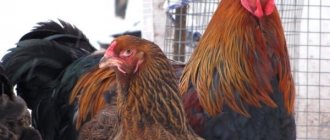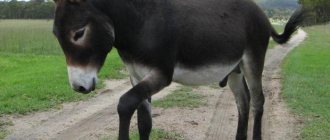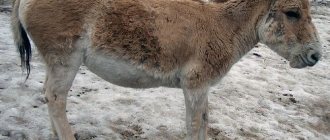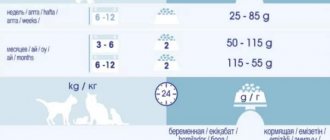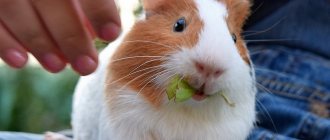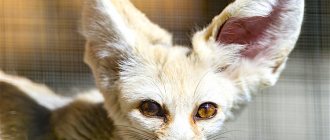The domestic donkey (lat. Equus asinus asinus), or donkey, is a domesticated subspecies of the wild donkey (Equus asinus), which played an important historical role in the development of human economy and culture and is still widespread (more than 40 million) in the economies of many developing countries.
A small number of donkeys are kept for breeding or as pets in developed countries. The donkey has been used as a working animal for at least 5,000 years.
The first donkeys were domesticated around 3000 BC. BC, probably in Egypt or Mesopotamia, and spread throughout the world.
All domesticated donkeys are African donkeys, but attempts to domesticate kulans (Asian donkeys) have always been unsuccessful. While the number of domesticated species is growing, African wild asses are an endangered species.
Photo:
Scientific classification:
- Domain: Eukaryotes;
- Kingdom: Animals;
- Subkingdom: Eumetazoa;
- No rank: Bilaterally symmetrical;
- No rank: Deuterostomes;
- Phylum: Chordata;
- Subphylum: Vertebrates;
- Infratype: Gastrostomes;
- Superclass: Quadrupeds;
- Class: Mammals;
- Subclass: Beasts;
- Clade: Euteria;
- Infraclass: Placental;
- Superorder: Laurasiatheria;
- Order: Perissodactyls;
- Family: Equines;
- Subfamily: Equinae;
- Tribe: Equini;
- Genus: Horses;
- Species: Wild ass;
- Subspecies: Domestic donkey.
What is the difference between a donkey and a donkey?
In fact, this animal can be described as small, gray and very stubborn. But such an answer to the question posed can only be given by people who are not specialists.
Therefore, this statement will not correspond to reality. In fact, donkeys have many advantages.
These animals have the following qualities:
- ease of care;
- pickiness in food;
- high endurance;
- large load capacity.
Many signs can be given on the basis of which we can conclude that this particular animal is better suited for a person to use on the farm than a horse.
What is the difference between a donkey and a donkey? If you look at this issue, there are no significant differences between them. After all, we are talking about the same species. They differ only in their name, which determines their habitat.
The Virtues of a Stubborn Donkey
If you look at the photos of these animals, it will immediately become clear that there are no serious differences between them. But probably few people will refuse to learn about their advantages. Both of these animals have an excellent instinct for self-preservation.
Everyone knows that a horse can easily die if it is driven. But you can't do this with a donkey. He will demand rest for himself, and if he does not get it, he will not begin to move. It is with this feature that the widespread belief is connected that these animals are very stubborn.
Diet
Photo: Anthony Rae
Donkeys are herbivores . They will use any food available. Riparian vegetation and grass pastures provide important food for animals in spring and summer. Because donkeys are opportunists, they have a significant negative impact on native vegetation. The greatest impact on vegetation occurs near water.
Notably, animals in high-density populations eat lower quality feeds with higher crude fiber content than animals in low-density populations.
What is the difference between a donkey and a mule?
Mules
A mule is considered to be a hybrid created by crossing a male donkey and a female horse. Therefore, it is possible to detect signs characteristic of each of the parents. He looks like his dad with his long ears and the same long roar.
All other features he inherited from his mother. Given the excellent endurance of this animal, it has also become widespread in economic activity.
Communication
Donkeys use auditory, visual, tactile and olfactory communication. They have excellent vision , acute hearing and a well-developed sense of smell.
Photo: Ansgar Scheffold
They are characterized by three main vocalizations:
- the roar is the most complex, it is used when meeting with relatives, during copulation, in antagonistic encounters and in foals separated from their mothers;
- growls are antagonistic vocalizations that communicate position relative to other animals;
- snorting is an alarm signal.
Tactile communication takes the form of nasal/nasogenital contact or mutual grooming of the withers.
Photo: Brian Wangenheim
In olfactory communication, the donkey's muzzle is raised to the sky, the upper lip is compressed and extended forward, the upper teeth and gums are exposed, and the nostrils are wrinkled. This behavior exposes the vomer and nasal organ.
Description
The breeding season for domestic donkeys most often occurs in spring and early summer, but it does not have a clear timing. Most often one foal is born, rarely two.
Twins are born in approximately 1.7% of cases; Both foals survive in about 14% of them. A normal pregnancy is considered to last from 11 to 14 months. The foal feeds on milk for up to 6-9 months, and begins to taste grass within two weeks after birth.
Reaches full growth by two years. At the age of two, donkeys are gradually accustomed to work; already at the age of three, donkeys can regularly perform not very hard work. Early use of a donkey under a pack can cause the young animal to bend its back.
Working donkeys in the poorest countries have a life expectancy of 12 to 15 years, while in more developed countries their life expectancy can range from 30 to 50 years.
Depending on the breed, donkeys can have a height of 90-163 cm; the height of purebred donkeys can vary from the size of a pony to the size of a good horse.
Representatives of the Poitous (height 140-155 cm) and Catalan (height 135-163 cm) breeds are considered the largest. The weight of adult animals is from 200 to 400 kg. The color of donkeys depends on the breed.
A donkey has 31 pairs of chromosomes. Pulse - 45-55 beats per minute. Respiratory rate - 10-15 respiratory movements per minute. Body temperature - 37.5-38.5 °C. Donkeys have only five lumbar vertebrae (horses have six).
A donkey has a tail with a tassel at the end, like a cow's.
Donkeys are adapted to desert lands. Unlike wild horses, wild asses in dry areas lead a solitary lifestyle and do not form harems.
Each adult donkey establishes a habitat; reproduction over a large area can be carried out by one group. The loud call or bray of a donkey, which usually lasts twenty seconds, can be heard for more than three kilometers.
Roaring helps maintain communication with other donkeys across vast areas of the desert. Donkeys have large ears, which can detect sounds over long distances or cool the donkey's blood. Donkeys can defend themselves by biting with their teeth, striking with their front hooves, or kicking with their back legs.
The donkey differs from its larger relatives in that it tolerates the lack of feed and water much more easily. It feeds on herbaceous and shrubby vegetation.
These animals do not tolerate dampness well and need dry rooms in winter; their hooves are especially often affected by dampness, which require special care in a humid climate.
Donkeys have a notorious reputation for being stubborn, but this is due to a much stronger sense of self-preservation than horses.
Donkeys subtly understand the limit of their physical capabilities and do not allow a person to cross it, piling on an unbearable burden, or forcing the donkey to work until complete exhaustion.
When a person earns the trust of donkeys, they can become a friendly partner and very reliable in their work. Although research on their behavior and intelligence is fairly sparse, donkeys appear to be quite intelligent, wary, friendly, playful, and eager to learn.
Features of character and lifestyle
Photo: Female donkey
The time of activity is dictated by nature itself - during the day it is hot, and therefore wild donkeys rest, finding a place in the shade and, if possible, cooler. They come out of hiding and start looking for food at dusk and do this all night. If they fail to refresh themselves, they can continue with the onset of dawn. In any case, this does not last long: soon it becomes hot, and they still have to find shelter so as not to lose too much moisture due to the scorching sun.
A donkey can do all this either alone or as part of a herd. Often, moving in one direction night after night, wild donkeys wander long distances. They do this in search of places more abundant in vegetation, but their wanderings are limited by civilization: having stumbled upon places developed by humans, they turn back to their wild lands. At the same time, they move slowly so as not to overheat and not waste too much energy.
The need to save energy is so ingrained in their minds that even the descendants of long-domesticated animals move in the same leisurely manner, and it is very difficult to induce a donkey to increase its speed, even if it is well fed and watered in cool weather. They have excellent eyesight and hearing; previously they were necessary against predators: donkeys noticed hunters from afar and could flee from them. There were rare moments when they developed high speeds - up to 70 km/h.
There are now almost no predators in their range, but they remain very cautious. Individuals living alone are territorial: each donkey occupies an area of 8-10 square kilometers and marks its boundaries with dung heaps. But even if a relative violates these boundaries, the owner usually does not show aggression - at least until the aggressor decides to mate with his female.
Taming
The domestication of the donkey took place much earlier than the horse. Donkeys were the first animals used by ancient man to transport goods.
Already around the XL century BC. e. Domesticated Nubian donkeys were kept in the Nile Delta. In Mesopotamia, wild donkeys were domesticated not much later. In ancient times, donkeys came to Europe.
It is known that the Etruscans had donkeys of Asia Minor origin. Donkeys came to Greece around 1000 BC. e. Donkeys were originally used for riding and pulling carts, but were replaced by them with the advent of faster and stronger horses.
Since then, references to donkeys in ancient cultures have almost ceased. The use of the donkey began to be limited to loading it with loads.
In this matter, the donkey has an advantage over the horse, since it is extremely hardy and is able to go much longer without water and food. The weight of the packs can reach up to two-thirds of the live weight of the animal, and in exceptional cases it can even exceed it.
With the right daily routine, a donkey can work for 8-10 hours with one break for feeding.
Donkeys were sometimes used for meat, milk and leather. In the Middle Ages, donkey skin was considered the most suitable for making parchment and drums. North of the Alps, donkeys began to be found only from the time of the Romans.
Scientific classification
- Kingdom: Animalia (animals)
- Phylum: Chordata
- Class: Mammalia (mammals)
- Order: Perissodactyla (oddactyls)
- Family: Equidae (equines)
- Genus: Equus (horse)
- Species: Equus asinus (wild ass)
The scientific name of the wild ass comes from two Latin words: "Equus", meaning horse, and "Asinus", meaning donkey, which comes from the archaic word "asnos".
Photo: Crookwell Gazette
Crossbreeding
Hinny
Through interspecific crossing of donkeys and horses, two sterile hybrid forms appear:
- mule (a hybrid of a donkey and a mare);
- hinny (a hybrid of a stallion and a donkey).
Like other interspecific hybrids, mules and hinnies are usually sterile, but have the stamina of a donkey and the physical strength and speed of a horse. Donkeys can also breed with zebras, the offspring of which are called zebroid.
Religion
In Christianity
On a young donkey, Christ, as the King of the world, rode into Jerusalem on Palm Sunday for the Death of the Cross, as it is written about in the Gospel, fulfilling the prophecy of Zechariah: “Rejoice with joy, daughter of Zion, rejoice, daughter of Jerusalem: behold, your King is coming to you, Righteous and Savior, Meek, sitting on a donkey and on the colt of a donkey, the son of the yoke” (Zech. 9:9). The twelfth holiday of Palm Sunday is dedicated to this event.
In Islam
Allegorical description of a donkey
, loaded with books, originates from the text of the Quran (62:5):
An example of those who were entrusted with (following) the Torah, and who subsequently did not adhere to it, (is) the example of a donkey
(Arabic: الْحِمَارِ, al-himari), who carries (large) books. How bad is the comparison with those people who (consider) the signs of God to be lies! God does not lead (directly) unjust people. (Quran 62:5).
Subsequently, the metaphor was used by the French writer and philosopher of the Renaissance Michel de Montaigne:
The most important thing is to instill taste and love for science; otherwise we will raise just donkeys loaded with bookish wisdom.
According to the Sunnah, eating the meat of a domestic donkey is prohibited. Jabir said: “On the day of Khaybar, the Messenger of Allah forbade eating the meat of domestic donkeys and allowed eating horse meat.”
As for wild donkeys, they are permitted, as related by Abu Qatada, who once asked the Messenger of Allah: “O Messenger of Allah, we hunted a wild donkey and we still have its meat,” to which he replied: “ Eat what's left too."
Benefits for humans
Today, many nationalities are engaged in breeding donkeys.
And this is not done by chance, because these animals bring great benefits:
- In Mexico and central America, this animal is one of the popular modes of transport. Moreover, you should not underestimate the donkey, since in some cases it can be more effective than a car or even the most powerful horse;
- During the reign of Cleopatra, breeding females that provided the owner with milk was considered a popular practice. This product was very useful, which was due to its properties: it helps to lose weight, has a rejuvenating effect, makes facial skin lighter;
- Donkeys have a large presence in many countries. Our country, where donkey farms operate, is no exception. But they are created for a reason, but for the purpose of making a profit. These animals are valued for their wool, meat and milk. Moreover, the number of people wishing to purchase these products increases every year.
Also, this fold-eared animal has become a popular image, which is used in many cartoons.
And if you ask children to name their favorite characters, they will probably remember this animal too. Moreover, in each case, the image of good-natured creatures with a vulnerable soul is created for donkeys.
How to care for an animal?
Let's look at the main points and tips for caring for donkeys
:
- The donkey eats in quantities that are minimal for an animal. The daily requirement is about 1 kilogram of grain per day. They can also eat carrots and beets. They should be fed no more than three times a day;
- They can graze and live in any conditions, without requiring a certain comfort;
- An animal can exist for several days without water or food at all.
Social structure
The social organization of donkeys consists of individuals, small groups, large groups and herds. For example, in Ethiopia, 5% of the population is solitary, 28% are groups of 2-6 individuals, 31% are groups of 7-20 individuals and 36% are herds of 21-60 individuals.
Photo: Jonathan Diemel
Small groups usually consist of one male and several females, or exclusively adult males or females. Large groups contain 1 or more males and up to 10 females; some large groups consist of only females. The herds consist of 25% males, the remaining members are females and their offspring. There are no permanent groups, except for small groups consisting of 2-3 year old young animals with their mother. gather during the day to feed , but in the evening they disperse again.
Adults of both sexes predominate over young animals. In large groups there is no consistent leadership; any adult can lead the group for a short time. There is no antagonistic behavior when there is a change in leadership.
Interesting Facts
- Donkey and horse are close relatives.
- In their natural environment, they live in herds, the number of which can be about 1000 individuals.
- In ancient times, the donkey was especially revered by the Indo-Europeans, who elevated it to the rank of a sacred animal.
- Donkeys are long-lived, with an average lifespan of 30 years. However, there is historical evidence that some representatives of this species lived up to 60 years.
Origin
Representatives of the equine family in Africa are known from the end of the Middle Miocene to the present. The forms from which the donkey evolved were first discovered in North Africa and date back to the early Pleistocene. Apparently, by the end of the Pleistocene they already occupied areas of the Mediterranean and Red Sea.
In Asia, wild asses appeared at the end of the Middle or Upper Pleistocene. African asses appeared at the end of the Upper Pleistocene in the Levant and North Africa. Their populations gradually spread westward across North Africa during the Neolithic, displacing the savannah zebra. This process may have been partly related to the domestication of the wild ass.
